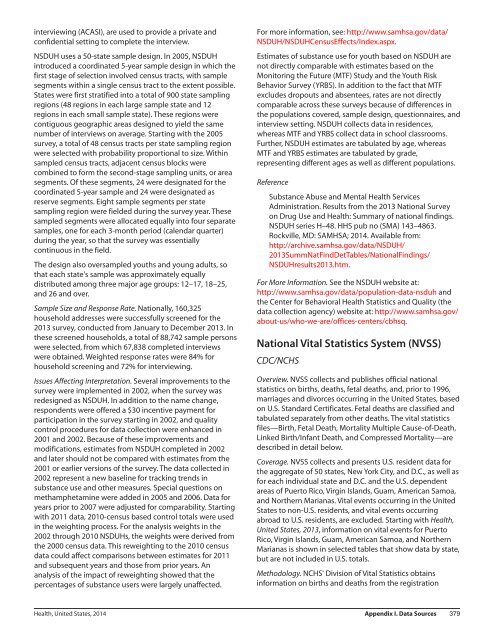hus14
hus14
hus14
You also want an ePaper? Increase the reach of your titles
YUMPU automatically turns print PDFs into web optimized ePapers that Google loves.
interviewing (ACASI), are used to provide a private and<br />
confidential setting to complete the interview.<br />
NSDUH uses a 50-state sample design. In 2005, NSDUH<br />
introduced a coordinated 5-year sample design in which the<br />
first stage of selection involved census tracts, with sample<br />
segments within a single census tract to the extent possible.<br />
States were first stratified into a total of 900 state sampling<br />
regions (48 regions in each large sample state and 12<br />
regions in each small sample state). These regions were<br />
contiguous geographic areas designed to yield the same<br />
number of interviews on average. Starting with the 2005<br />
survey, a total of 48 census tracts per state sampling region<br />
were selected with probability proportional to size. Within<br />
sampled census tracts, adjacent census blocks were<br />
combined to form the second-stage sampling units, or area<br />
segments. Of these segments, 24 were designated for the<br />
coordinated 5-year sample and 24 were designated as<br />
reserve segments. Eight sample segments per state<br />
sampling region were fielded during the survey year. These<br />
sampled segments were allocated equally into four separate<br />
samples, one for each 3-month period (calendar quarter)<br />
during the year, so that the survey was essentially<br />
continuous in the field.<br />
The design also oversampled youths and young adults, so<br />
that each state's sample was approximately equally<br />
distributed among three major age groups: 12–17, 18–25,<br />
and 26 and over.<br />
Sample Size and Response Rate. Nationally, 160,325<br />
household addresses were successfully screened for the<br />
2013 survey, conducted from January to December 2013. In<br />
these screened households, a total of 88,742 sample persons<br />
were selected, from which 67,838 completed interviews<br />
were obtained. Weighted response rates were 84% for<br />
household screening and 72% for interviewing.<br />
Issues Affecting Interpretation. Several improvements to the<br />
survey were implemented in 2002, when the survey was<br />
redesigned as NSDUH. In addition to the name change,<br />
respondents were offered a $30 incentive payment for<br />
participation in the survey starting in 2002, and quality<br />
control procedures for data collection were enhanced in<br />
2001 and 2002. Because of these improvements and<br />
modifications, estimates from NSDUH completed in 2002<br />
and later should not be compared with estimates from the<br />
2001 or earlier versions of the survey. The data collected in<br />
2002 represent a new baseline for tracking trends in<br />
substance use and other measures. Special questions on<br />
methamphetamine were added in 2005 and 2006. Data for<br />
years prior to 2007 were adjusted for comparability. Starting<br />
with 2011 data, 2010-census based control totals were used<br />
in the weighting process. For the analysis weights in the<br />
2002 through 2010 NSDUHs, the weights were derived from<br />
the 2000 census data. This reweighting to the 2010 census<br />
data could affect comparisons between estimates for 2011<br />
and subsequent years and those from prior years. An<br />
analysis of the impact of reweighting showed that the<br />
percentages of substance users were largely unaffected.<br />
For more information, see: http://www.samhsa.gov/data/<br />
NSDUH/NSDUHCensusEffects/Index.aspx.<br />
Estimates of substance use for youth based on NSDUH are<br />
not directly comparable with estimates based on the<br />
Monitoring the Future (MTF) Study and the Youth Risk<br />
Behavior Survey (YRBS). In addition to the fact that MTF<br />
excludes dropouts and absentees, rates are not directly<br />
comparable across these surveys because of differences in<br />
the populations covered, sample design, questionnaires, and<br />
interview setting. NSDUH collects data in residences,<br />
whereas MTF and YRBS collect data in school classrooms.<br />
Further, NSDUH estimates are tabulated by age, whereas<br />
MTF and YRBS estimates are tabulated by grade,<br />
representing different ages as well as different populations.<br />
Reference<br />
Substance Abuse and Mental Health Services<br />
Administration. Results from the 2013 National Survey<br />
on Drug Use and Health: Summary of national findings.<br />
NSDUH series H–48. HHS pub no (SMA) 143–4863.<br />
Rockville, MD: SAMHSA; 2014. Available from:<br />
http://archive.samhsa.gov/data/NSDUH/<br />
2013SummNatFindDetTables/NationalFindings/<br />
NSDUHresults2013.htm.<br />
For More Information. See the NSDUH website at:<br />
http://www.samhsa.gov/data/population-data-nsduh and<br />
the Center for Behavioral Health Statistics and Quality (the<br />
data collection agency) website at: http://www.samhsa.gov/<br />
about-us/who-we-are/offices-centers/cbhsq.<br />
National Vital Statistics System (NVSS)<br />
CDC/NCHS<br />
Overview. NVSS collects and publishes official national<br />
statistics on births, deaths, fetal deaths, and, prior to 1996,<br />
marriages and divorces occurring in the United States, based<br />
on U.S. Standard Certificates. Fetal deaths are classified and<br />
tabulated separately from other deaths. The vital statistics<br />
files—Birth, Fetal Death, Mortality Multiple Cause-of-Death,<br />
Linked Birth/Infant Death, and Compressed Mortality—are<br />
described in detail below.<br />
Coverage. NVSS collects and presents U.S. resident data for<br />
the aggregate of 50 states, New York City, and D.C., as well as<br />
for each individual state and D.C. and the U.S. dependent<br />
areas of Puerto Rico, Virgin Islands, Guam, American Samoa,<br />
and Northern Marianas. Vital events occurring in the United<br />
States to non-U.S. residents, and vital events occurring<br />
abroad to U.S. residents, are excluded. Starting with Health,<br />
United States, 2013, information on vital events for Puerto<br />
Rico, Virgin Islands, Guam, American Samoa, and Northern<br />
Marianas is shown in selected tables that show data by state,<br />
but are not included in U.S. totals.<br />
Methodology. NCHS' Division of Vital Statistics obtains<br />
information on births and deaths from the registration<br />
Health, United States, 2014 Appendix I. Data Sources 379


